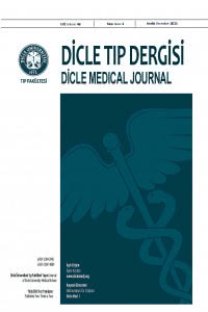Ureteroscopy and Laser Lithotripsy for Treatment of Ureteral Stones in Pregnants: Single Center Experience
Gebelik, ürolitiyazis, üretereskopi, litotripsi, Holmium-YAG lazer
Determining a Safe Time for Oral Intake Following Pediatric Sedation
-,
___
- Korkes F, Rauen EC, Heilberg IP. Urolithiasis and pregnancy.
- Jornal Brasileiro de Nefrologia 2014;36:389-395.
- Bozkurt Y, Soylemez H, Atar M, et al. Effectiveness and safety of ureteroscopy in pregnant women: a comparative study. Urolithiasis 2013;41:37-42.
- Fregonesi A, Dias FG, Saade RD, et al. Challenges on percutaneous
- nephrolithotomy in pregnancy: Supine position approach through ultrasound guidance. Urology Annals 2013;5:197-199.
- Hanson B, Tabbarah R. Preterm delivery in the setting of left calyceal rupture. Case Reports Obstetrics Gynecol 2015;2015:906073.
- Celik O, Turk H, Cakmak O, et al. Current approach for urinary
- system stone disease in pregnant women. Archivio Italiano di Urologia, Andrologia 2016;87:280-285.
- Masselli G, Weston M, Spencer J. The role of imaging in the diagnosis and management of renal stone disease in pregnancy.
- Clin Radiol 2015;70:1462-1471.
- Turk C, Petrik A, Sarica K, et al. EAU Guidelines on Interventional
- Treatment for Urolithiasis. Eur Urol 2016;69:475-482.
- Akinci M, Esen T, Tellaloğlu S. Urinary stone disease in Turkey: An updated epidemiological study. Eur Urol 1990;20:200-203.
- Hernandez N, Pais VM, Jr. Diagnostic and management considerations for nephrolithiasis in the gravid patient. Clin Nephrol 2016;85:70-76.
- Erdem E, Abidinoğlu D. Gebelik ve Üriner Sistem Taş Hastalığı.
- Turk Urol Sem 2011;2:127-130.
- Teleb M, Ragab A, Dawod T, et al. Definitive ureteroscopy and intracorporeal lithotripsy in treatment of ureteral calculi during pregnancy. Arab J Urol 2014;12:299-303.
- Wymer K, Plunkett BA, Park S. Urolithiasis in pregnancy: a cost-effectiveness analysis of ureteroscopic management vs ureteral stenting. Am J Obstetr Gynecol 2015;213:691e1-8.
- Song Y, Fei X, Song Y. Diagnosis and operative intervention for problematic ureteral calculi during pregnancy. Int J Gynecol Obstetric 2013;121:115-118.
- Rivera ME, McAlvany KL, Brinton TS et al. Anesthetic exposure in the treatment of symptomatic urinary calculi in pregnant women. Urology 2014;84:1275-1278.
- Sancaktutar AA, Atar M, Söylemez H, et al. Effectiveness of 4.5 F semirigid ureteroscope (Mini-URS) in the management of ureteral stones in children younger than 3 years of age. Turk J Urol 2011;37:335-340.
- Üçer O, Şahin MO, Canda AE, et al. Üreter taşı lokalizasyonuna
- göre rijid üreteroskopinin başarısı. Dicle Tıp Derg 2010;37:21-24.
- Yüksel MB, Çelen İ, Özbek E, et al. Üreter taşlarında pnömotik
- ve lazer litotripsi tekniklerinin maliyet-etkinlik analizi. Dicle Tıp Derg 2013;40:75-80.
- .Adanur S, Ziypak T, Bedir F, et al. Ureteroscopy and holmium
- laser lithotripsy: is this procedure safe in pregnant women with ureteral stones at different locations? Archivio Italiano di Urologia, Andrologia 2014;86:86-89.
- Hoscan MB, Ekinci M, Tunckiran A, et al. Management of symptomatic ureteral calculi complicating pregnancy.Urology 2012;80:1011-1014.
- ISSN: 1300-2945
- Yayın Aralığı: 4
- Başlangıç: 1963
- Yayıncı: Cahfer GÜLOĞLU
Kaudal Epidural Steroid Enjeksiyonu Sonrası Gelişen Nadir Bir Komplikasyon: İnatçı Hıçkırık
Ayhan KAYDU, Erhan DÖKÇEK, Cem Kıvılcım KAÇAR, MAHİR KUYUMCU
Bir Üniversite ve Devlet Hastanesi Üreteroskopik Litotripsi Sonrası Stent Yerleştirilme Sıklığı
Huseyin Celik, Ahmet Camtosun, Caner Ediz, Ibrahim Topcu, Ramazan Altintas, Cemal Tasdemir
Determination of P-Glycoprotein Expression by Flow Cytometry in Hematological Malignancies
BERKAY SARAYMEN, AYSUN ÇETİN, Behzat ÇİMEN, İHSAN ÇETİN, MUSTAFA YAVUZ KÖKER, Bülent ESER
Atypical Papular Purpuric Eruption Induced by Parvovirus B19 Infection
Şeyma KAYALI, NİLDEN TUYGUN, HALİSE AKÇA, CAN DEMİR KARACAN
Laparoskopik Ürolojik Cerrahi Başlangıç Deneyimlerimiz
Selçuk Altın, Ramazan Topaktaş, Ali Akkoç, Cemil Aydın, Reha Girgin, Zeynep Aydın, Kadir Yıldırım
Clinicohematological Profile of Pancytopenia: A Study from a Tertiary Care Hospital
Monica GUPTA, Abha CHANDNA, Sanjay KUMAR, Sant Prakash KATARİA, Sonia HASİJA, Gajender SINGH, Rajeev SEN
Effects of Prokinetic Agents on Motility of Proximal and Distal Colon
Mehmet Arslan, Ahmet ALTUN, Cengiz GÜNEY, Levent Cankorkmaz, İhsan Bağcıvan, Gökhan KÖYLÜOĞLU
Ömer KAYNAR, Nurinnisa ÖZTÜRK, Fatih Kıyıcı, Nurcan BAYGUTALP, Ebubekir Bakan
Malign Adneksiyal Kitlelerin Tanısında Donuk (Frozen) Kesit İncelemesinin Doğruluğu
Nuri Yıldırım, Alkım Şahingöz Yıldırım, Ahmet Ergenoğlu, Ahmet Yeniel, Osman Zekioğlu, Necmettin Özdemir, M. Coşan Terek
Pediatrik Sedasyon Sonrası Oral Alım için Güvenli Zamanın Belirlenmesi
Yunus ATALAY, Cengiz Kaya, Ersin KOKSAL, Yasemin USTUN, Leman TOMAK
